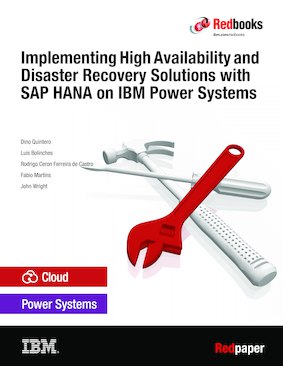
Published on 23 October 2017, updated 05 February 2018
Read in Google Books
Share this page:
ISBN-10: 0738456357
ISBN-13: 9780738456355
IBM Form #: REDP-5443-00
Authors: Dino Quintero, Luis Bolinches, Rodrigo Ceron Ferreira de Castro, Fabio Martins and John Wright
Abstract
This IBM® Redpaper™ publication addresses topics for architects, brand specialists, distributors, resellers, and anyone developing and implementing SAP HANA on IBM Power Systems™ integration, automation, high availability (HA), and disaster recovery (DR) solutions. This book provides documentation to transfer how-to-skills to the technical teams, and documentation to the sales team.
This guide describes how to implement an SAP HANA on IBM Power Systems solution from end to end and includes HA and DR guidelines by using theoretical knowledge, field experience, and sample scenarios.
The contents of this book follow the guidelines from SAP regarding HANA installation on IBM Power Systems plus all the preferred practices that are gathered from the experiences of those consultants in hundreds of past HANA installations in customers’ environments.
This book is a hands-on guide and is targeted at technical staff who want to install SAP HANA on IBM Power Systems, and also use SAP HANA and IBM Power Systems HA solutions.
SAP HANA and SUSE screen captures that are used in this publication belong to their respective owners. The residency team showed them in the publication to demonstrate the implementation and integration parts of the solution with IBM Power Systems.
Table of Contents
Chapter 1. Introduction
Chapter 2. Planning your installation
Chapter 3. IBM PowerVM and SAP HANA
Chapter 4. SUSE Linux Enterprise Server for SAP Applications V12 SP2 installation and customization
Chapter 5. Storage and file systems setup and customization
Chapter 6. System evaluation
Chapter 7. SAP HANA software stack installation for a scale-up scenario
Chapter 8. SAP HANA software stack installation for a scale-out scenario
Chapter 9. SAP HANA Systems Replication for high availability and disaster recovery scenarios
Chapter 10. SUSE high availability configuration for a two-node high availability scenario